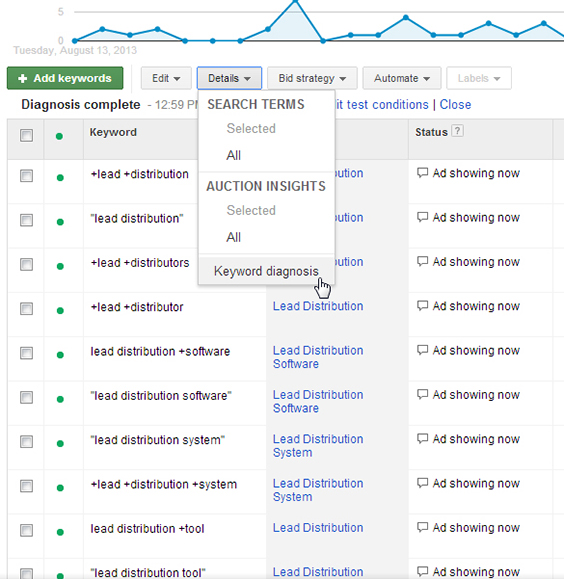Your ads are the connection between the visitor and your brand, and need to be more than an “attention-grabber” if you want to increase your conversion rate and improve your ROI. The content of your ad is an extension of the content on your page, but in a very, very condensed format.
Creating an effective ad is a matter of pitching your visitor before they’ve ever visited the page. It becomes even more complicated because your competitor’s are sharing the same space with you, and since there are only a few things you can do to stand out from them, which includes your unique selling point, your headline, and your call-to-action, each thing matters.
Knowing Your Brand Image and USP (Unique Selling Point)
Even in the very limited format for ads that AdWords and other PPC advertising often provides, you need to be able to convey either your brand image or your unique selling point (or both) to differentiate you from your competitors. Although the average position of your ad makes a difference, having one of those coveted top spots will not be effective if your ad does not sell what you’re actually selling. This can result in a potential customer skipping your ad, or worse, clicking and then bouncing immediately.
If you’re looking to drive traffic, focus more on your brand image. What do people associate your brand with? Why is advertising on this particular keyword worth it to your brand image? It may be your brand name – getting a spot in the ads for your name means that someone else won’t have it. For a business focused on ROI, this is the only time I recommend having a brand-focused ad rather than a product-focused ad, unless your brand already has a very strong presence in your vertical.
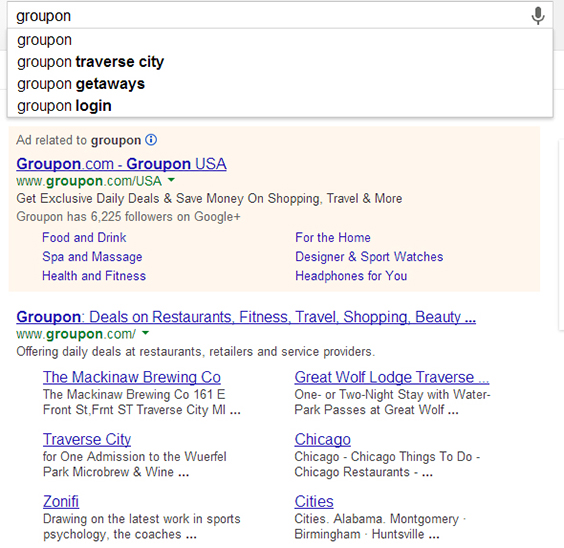
Groupon is advertising for Groupon to get double the listings
With a clearly-defined brand, developing a brand-based ad should not be difficult even with the character limitations. Describe your brand in just a phrase – if that’s too hard, work on developing one. It will make the entire advertising process easier, not just the PPC.
For a product/service based ad, determine your unique selling point (USP), and fit that into your ad. Having different wording from a competitor is not enough to make it distinct. Are your cable ties the most affordable on the market? Is your law firm the largest and most respected in your area?
Think about how to describe your USP in just one or two words – chances are, putting it in an actual ad will expand it somewhat, and since there’s not much room to work with, you need to start small. Developing your ad around your USP will make it distinct without the need for awkward, purely attention-grabbing headlines and text.
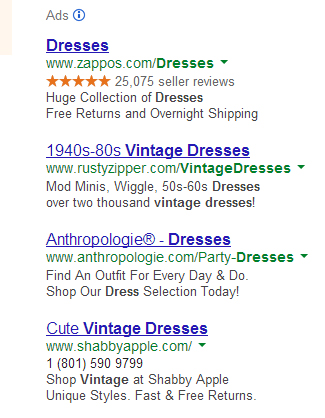
Cool, edgy vintage dresses, with free shipping is a great USP
Developing the right ads
Create your ads with your persona in mind, and don’t be afraid to experiment and…borrow ideas from other successful ads. When developing a unique ad, consider the four major sections of a normal PPC ad (and all are important for an effective ad!):
-
- The Headline: Remember dividing your keywords up into appropriate ad groups? This makes the headline creation easy. You want to describe your product or service – in this case, your keyword – in your headline. Don’t go for an “attention grabbing” headline; if a user doesn’t think it relates to what they’re looking for right away, they will skip over your ad.An easy way to insert keywords is to use dynamic headlines. Insert {KeyWord: Placeholder} into your headline and replace the placeholder with a default headline for that ad group. The headline will then dynamically generate depending on the keyword your potential customer matched to (not their actual search term). If you have long-tail keywords that are longer than the 25-character limit, your default headline will be used instead.

Kohl’s is likely using keyword insertion because of a massive stock
-
- The Description: Dedicate the 70 characters you get for your description on your unique selling point. Most often, I consider the USP more important than the call-to-action. Reiterate the product or service you’re selling (especially if you use a dynamic headline!), but dedicate the rest into making yourself distinct from other advertisers. Treat it like the 30 second elevator pitch – what can you say in just a sentence or two that would make even the pickiest customer choose you over others?If you have room, make your call-to-action specific and enticing – “Find Your Calling Today” is more personable than “Sign Up Today”, and it’s better to avoid the very common “Learn More” or “Buy Now”. You could even work your unique selling point into your call-to-action – for example “Discover The Most Affordable Way To Plant Your Dream Garden.”
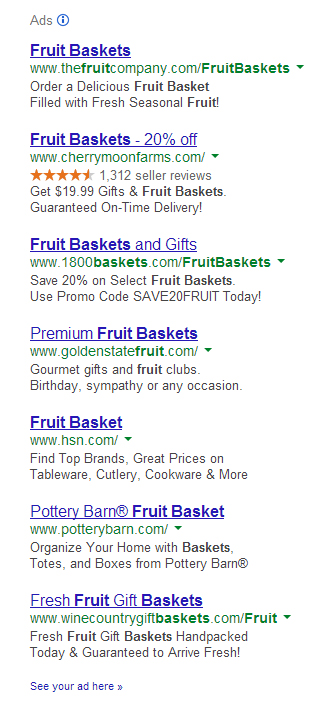
Many fruit baskets – the first company’s entire ad is their call to action
- The Display URL: While the Display url must contain your domain, you can use a vanity subdomain or page url to further reiterate your product or emphasize your unique selling point. If your url is too long (35 characters) it will truncate the url in the actual ad, so this is only useful if your domain name is not overly long.
- The Destination URL: The destination url is important not just for conversions but for knowing how well your ads are actually performing. This url should lead to the landing page most relevant to your product – and it should work! Details about landing pages will be covered in the next chapter.
There is a wealth of information that can be found through the destination url. In addition to auto-tagging in AdWords, considering value tracking to better understand how your conversions are traveling through your site, and what medium they’re using to get there.
Dynamic Search Ads (another new feature with enhanced campaigns) allow ads to dynamically change both the headline AND the landing page depending on the keyword. It’s a more extreme form of the dynamic headline mentioned above, and is extremely effective for businesses that have hundreds of landing pages due to a large amount of products.
If you’re stuck on good wording for an ad, it doesn’t hurt to check out the competition. This can be done by looking at current ads with a Google Search for one of your keywords, but can also be done using whatrunswhere.com. This site will allow you to look at competitors’ past ads, and the ads are ranked based on their past performance. This will give you a base to work off of without directly copying an ad that a competitor is still running.

No need to see only the current ads – see the past ones too
Serving Your Ads
Where you show up in the auction will largely be determined by two things: Your ROI strategy and your competition. Wanting to drive the most traffic possible? You’ll want to aim for the top three positions on the page. They garner much higher clickthrough rates than the side ads. However, because of this, they are also the most competitive positions, and you may need a very high cost-per-click and quality score to have your ads show up there consistently.
Because of this, those who are focused on a positive ROI, especially starting out, will want to focus on conversion rates and cost-per-conversion rather than average position. In my personal experience, the top spot on the side ads (i.e. the fourth spot) is an effective spot for conversions at a lower price point. For less competitive keywords, the bottom of the top (the third spot) is also very effective, and will open up more options for ad extensions, which are discussed in Chapter 4.
When serving ads, it’s best to have multiple variations running at once, but make sure that you know what is different about the two or more ads that you’re serving. If the ad variations are too similar or too wildly different, it will be difficult to determine what exactly was effective about that particular ad. Was it the call-to-action? The headline? When you change ads (I recommend monthly), you will know what to change and what to keep the same in order to create the best ad. If the ads are too different, you may end up running an ad that performs worse for the same reason as its predecessor.
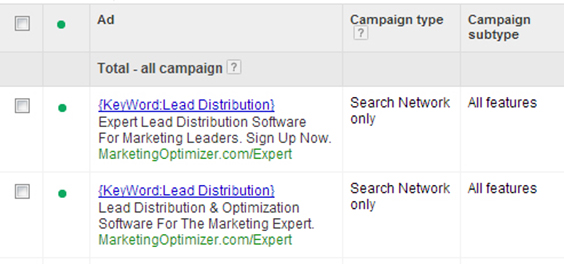
The only major difference? A call-to-action. Otherwise, fairly similar
It’s now possible with enhanced campaigns to develop normal text ads that will serve only on mobile devices that have full browsers (i.e. your average smartphone). Consider doing this if you have a dedicated mobile landing page. With it, you can appeal directly to mobile users with mobile-specific selling points like an app.
A few great tools for serving your ads properly are the competition analysis tool, the ad preview tool, and the ad diagnosis tool. These are tools that can be used early on, with no previous data, to review how your ads are running (if they’re running at all):
- Ad Preview Tool: With this (Under Tools and Analysis), you can check to make sure the ad is serving, where it’s showing up, and why it might not be showing. This is also a great way to check for mobile-specific ads without having to switch devices.It’s also a clean environment – there are so many factors that go into where your ad shows up, and a few of them depend on where you are and how much you’ve been searching on your own keywords. Because you don’t click on your own ads, this can cause your ad to drop in position when you search for it over and over again. The Ad Preview tool is there to prevent this from happening and causing unnecessary stress.
- Keyword Diagnosis: This tool is similar to ad preview (found under “details” in the Keyword tab) but allows you to diagnose the status of multiple keywords at once instead of one at a time. It will check to see if your ads are serving for the exact-match variation of that keyword, and will give a reason if it is not serving at that point.
Both of these tools are important when you want to make sure your ads are showing before data actually shows. It takes up to six hours for data to show up, and if something’s gone wrong, you’ll want to know before then.
Determining the Best Bid Strategy
Even in “set-it-and-go” bid settings, the bids in PPC require monitoring and adjustment based on the past performance of your ads. The strategies for bidding will vary depending on if you’re looking to drive traffic or attain a positive ROI. When choosing one of the following bid options, keep in mind the amount of time you will need to dedicate to bid changes, especially if you have third-party software to help you:
-
- Automatic Bidding: This is the most automated that the bidding can become, but is generally only effective when you’re looking to drive traffic, and it will likely not result in a positive ROI. Generally, the automatic bidder will place your ads at approximately fourth or fifth position (assuming your bid limit is not too low) and will try to drive as many clicks as possible, no matter how those ads are converting.
- CPC Bidding: This is the very opposite of automatic bidding – since all bids are controlled by you, it can be very time-consuming to adjust bids up and down to keep up with competition and performance. However, if you do have time to dedicate (or use third-party software to help automate some of the work) this will be an effective way to bid because you can make instant decisions based on your ads’ performance.

Keep in mind any bid modifications you may have, especially since all campaigns are now enhanced
- CPC Bidding (Enhanced): Enhanced bidding can be helpful if you have some conversion data, but not enough to use CPA bidding (explained below). AdWords will attempt to adjust your bids up or down by 20% depending on whether it thinks a particular auction will result in a conversion. There’s no way to control it other than adjusting your original bid. Because it’s working off of very little data, I would only recommend this if you feel you don’t have enough time to dedicate to purely CPC bidding.
- CPA (Cost-per-acquisition) Bidding: When you’re working with a lot of keywords, CPA bidding can be a great assistance in making everyday bid changes while still allowing you control over bid amounts. CPA bidding requires 15 conversions to be made in 30 days before it can be turned on. However, the more data you have, the more effective it will be. There are two ways to set the bids for CPA:
- Target CPA: This is how much you want to pay for a sale to create a positive ROI. AdWords will attempt to bid in order to meet this target. If the target is too strict, however, you may force your campaigns down to a small trickle (because it can’t find anywhere to bid that meets your target).
- Maximum CPA: If AdWords if having trouble meeting your target CPA at first, or you only care that you do not exceed a certain amount, you can set a maximum CPA. This should not exceed the cost + overhead of your product or service.
With enhanced campaigns, the option is now available to set a separate mobile bid without separating campaigns. The default setting is -20% of your original bid, but I recommend turning this up or down depending on the popular mediums for your site, and whether your site has a mobile-optimized landing page.
If a large amount of your traffic comes to your website on a mobile device, it’s effective to change the bid modifier to -10% or more – many advertisers will leave it at the default setting, and you can use this to your advantage.
A higher average position is preferred for mobile ads because there are less spots available – because there are no side ads, three ads will serve at the top, and two ads at the bottom the search results on any mobile device. Generally, you don’t need to bother with WAP mobile ads nowadays unless your vertical deals specifically with users who do not have full browsers, like blackberry phones.
Table of Content
[col span=”md-4″]
Chapter 1:
Effective Keywords
Chapter 4:
Adwords Advanced Settings
Chapter 7:
Analyzing Your PPC Data
[/col]
[col span=”md-4″]
Chapter 2:
Standout Ads
Chapter 5:
Bing and other PPC Avenues
Chapter 8:
Adwords Editor
[/col]
[col span=”md-4″]
Chapter 3:
Actionable Landing Pages
Chapter 6:
The Display Network
[/col]

